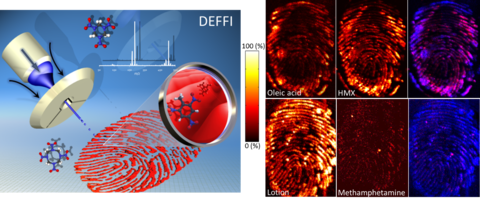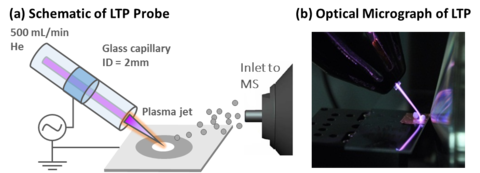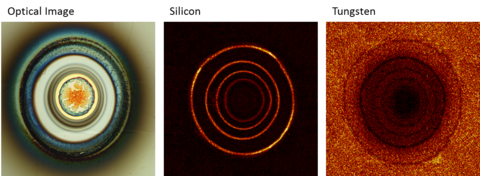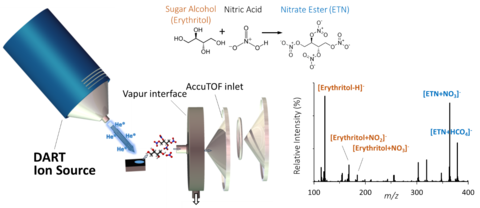Summary
Surface desorption ambient mass spectrometry enables direct solid surface interrogation for sampling and ionization of trace analytes. This project encompasses liquid-, plasma-, and laser-based ion sources. These versatile ion sources enable direct analysis of samples in situ, requiring minimal or no sample preparation. Real-time surface sampling also enables measurement of the spatial and temporal distribution of chemical species on surfaces under ambient or atmospheric conditions. Developments in surface desorption ambient mass spectrometry address metrology needs for safety, security, and forensic applications.
Description
The Surface and Trace Chemical Analysis Group maintains a range of research avenues into the characterization, analysis, and optimization of various commercial and in-house developed surface desorption ion sources. These research avenues also aim to advance our fundamental understanding of the physicochemical processes involved as well as application specific optimization and implementation. Below are a few examples of research conducted in these areas.
The ambient ion source desorption electro-flow focusing ionization (DEFFI) couples electro-flow focusing in a surface desorption configuration, similar to desorption electrospray ionization (DESI). DEFFI incorporates a concentric laminar gas flow that focuses a solvent stream through a small orifice from a recessed capillary. This configuration achieves a steady jet of micron sized droplets that can be charged through the application of an electric field. DEFFI enables stable jetting at low applied pressures and ionization regimes dominated by charged-droplet electrospraying or corona discharge chemical ionization. The DEFFI surface analysis ion source has been applied to the trace detection of narcotics , explosives, and elemental inorganics for applications including homeland security and forensic chemistry . The fine jetting produced by DEFFI was also applied to the chemical imaging of endogenous and exogenous components from artificial fingerprints as well as investigating chemical spatial distributions from wipe-collected analytes.

Another front-end source for ambient MS is the low temperature plasma (LTP). By passing electricity through a small volume of helium gas flowing in a tube, a filamentary discharge of metastable helium atoms can be created (Figure B). This filamentary discharge is used to probe the sample surface, from which molecules are desorbed and ionized for analysis inside a MS system. LTP can also rapidly etch through the sample and is a very destructive for a material desorption source. It is well suited for direct analysis inorganic material such as some metal particles. As a source of fluorine, gasses such as CF4 or SF6 can be mixed with helium to promote formation of volatile tetrafluoride and hexafluoride complexes (Figure C). The ambient LTP source can also be used to etch multilayer films for analysis of the crater wall by alternative techniques.


Direct analysis in real time (DART) is a commercial ion source that has experienced considerable interest and development as an analytical tool for the forensic science community. DART incorporates a heated gas stream for analyte desorption, followed by interaction with ions generated by the emission of helium metastables. An off-axis geometry for surface desorption was implemented for an investigation into the detection of sugar alcohol precursors, by-products, and corresponding nitrate ester explosives. These homemade explosives are synthesized through the nitration of readily available sugar alcohols (commonly found as artificial and alternative sweeteners). DART-MS demonstrated sensitive detection of the nitrate ester explosives from mixtures containing precursors and potential by-products. Other configurations have also been developed to readily sample, and in some cases quantitate, volatile compounds such as ethanol and other low molecular weight adulterants directly from liquid samples


